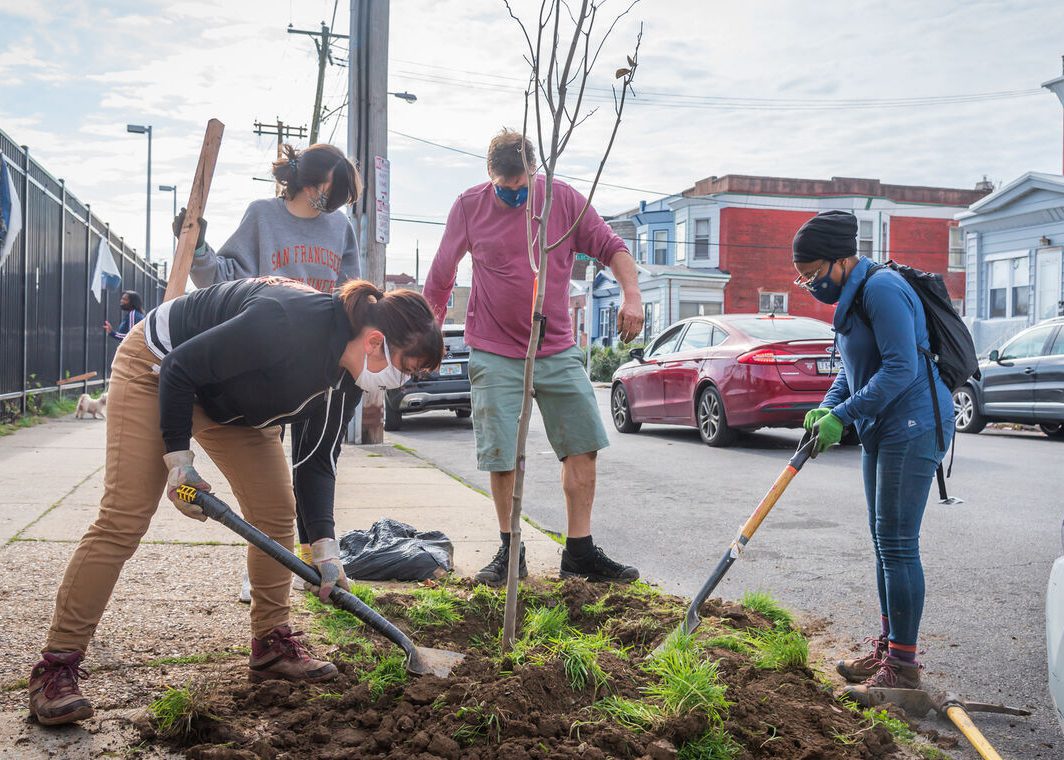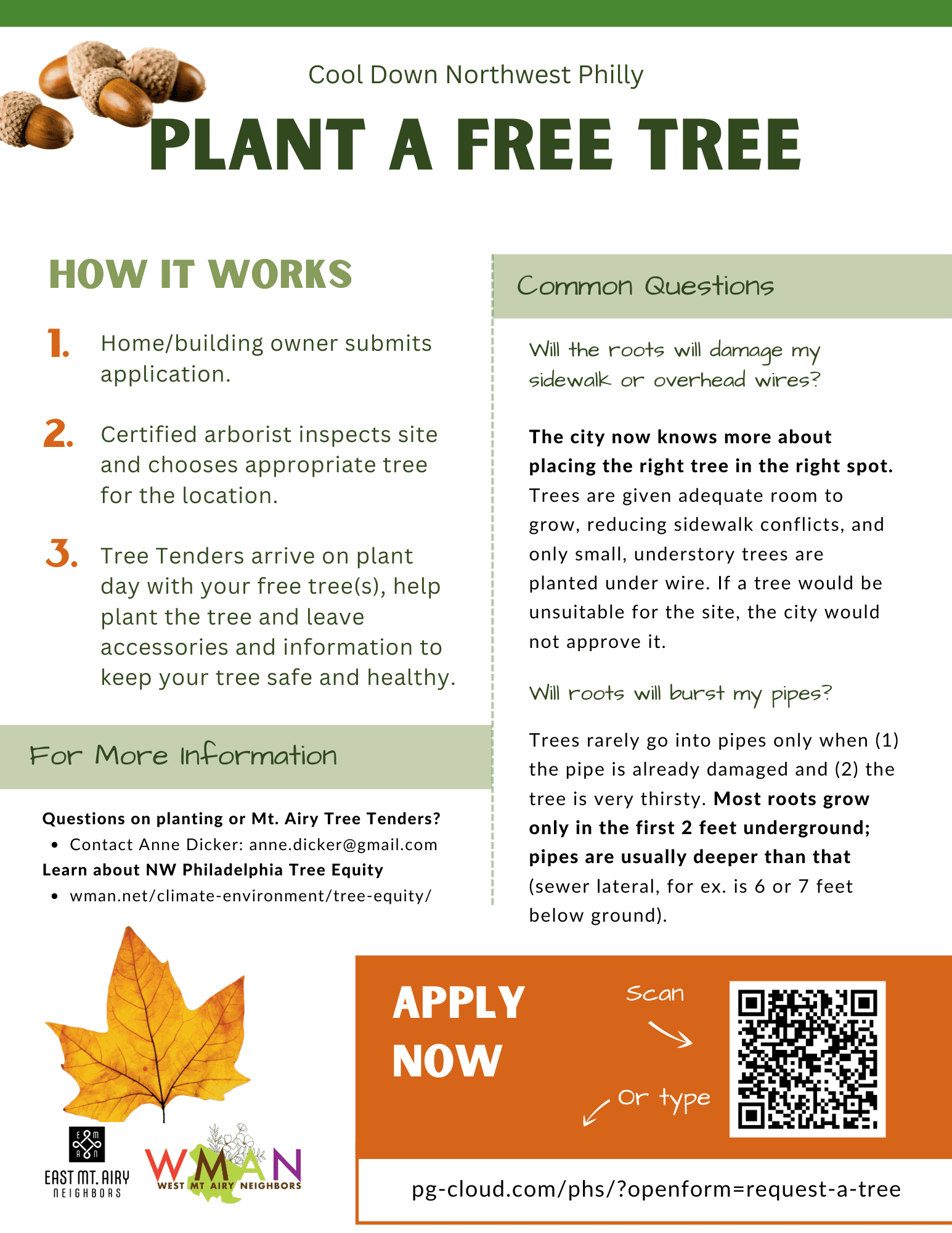Northwest Philadelphia Tree Equity Initiative
Mission Statement
The mission of the Northwest Philadelphia Tree Equity Initiative is to combat heat islands and further environmental and recognitional justice in these communities. We aim to engage residents in both planting and maintaining trees while providing education on the benefits of trees, particularly in areas of Northwest Philly with less canopy cover than others. This initiative will promote community stewardship over trees by including residents in the planting, maintaining, and organizing processes.

What is this program?
What are the goals of this program?
- To ensure that local residents have a clear understanding of the critical environmental problems created by treeless blocks in our neighborhoods and the impact of heat islands.
- To offer training and technical assistance – as well as trees – to ensure that our neighbors have the knowledge, skills, and resources to address these issues effectively.
- To ensure the planting and maintenance of 100 new trees in the year ahead – with the promise that the planting and maintenance/stewardship of new trees throughout the community will become a central priority for this neighborhood for years to come.
- To foster equity in canopy cover and address barriers to planting and maintaining trees to facilitate cooler streets in neighborhoods that are the hottest.
What will we do?
- Build a group of residents to go door-to-door, engaging with neighbors and educating them, through both interpersonal conversation and educational materials, about the importance of addressing heat island issues by planting and tending new trees to encourage street tree applications.
- Provide informal workshop training and on-site, hands-on instruction to a newly recruited team of neighbors related to planting trees and ensuring their survival over time, providing residents with the trees, tools, and technology needed to re-green our neighborhood.
- Develop educational materials and activities designed to introduce 100 neighborhood children – through informal educational programs and on-site, hands-on activities at a community-wide Arbor Day event– to prepare them to assist their families in this community-wide tree tending initiative.
- Support at least 25 neighbors who want to become certified PHS Tree Tenders to participate in the ‘certified tree tender program’ offered by the Pennsylvania Horticultural Society (PHS), our long-time partner in varied environmental education programs in our community.

Important tree information
Urban heat island effect and disparities in tree cover
The urban heat island effect results from Philadelphia’s dark, paved makeup. Much of this physical makeup is composed of dark materials, such as asphalt, for its streets, roofs, and buildings. These dark materials absorb heat close to the ground and release it slowly over time, unlike greenspaces, which release heat much more quickly and often provide shade. Other components, such as car emissions and smokestack exhaust, also make cities hotter. This is known as the urban heat island effect.
While the urban heat island effect plays a role in hot neighborhoods, heat is not distributed equally throughout the city. Factors such as proximity to a park and the number of trees to provide shade play a role in creating an up to 22℉ difference in heat between neighborhoods in the city (Heat Vulnerability Index highlights City hot spots | Department of Public Health | City of Philadelphia). As climate change continues to increase, some neighborhoods will be disproportionately impacted by the extreme temperatures that are continuously rising, largely due to disparities in tree cover, with some cities having under 5% tree canopy while others have 45% or more (Philly Tree Plan Executive Summary 1).
What are the stats on heat and tree cover?
 (1)
(1)
- According to a study conducted in Philadelphia, the city’s average annual temperatures are estimated to increase up to 5.8 ℉ by the 2050s and up to 9.4 ℉ by the 2080s (2)
- Researchers found that, as of 2021, there was an average of 6 days per year with maximum temperatures at or above 95 ℉. This number is estimated to range from 21 to 34 days per year by the 2050s and 34 to 72 days per year by the 2080s (3)
 (4)
(4)
 (5)
(5)
- New Urban Heat Map Underscores Need for Trees in Philadelphia Neighborhoods
- Heat Vulnerability Index: “The Philadelphia Heat Vulnerability Index shows the areas in the city that are most at-risk of experiencing heat-related illnesses during very hot weather. A block is more vulnerable if it is both very hot and if the people who live there are more sensitive to higher temperatures, like older folks and people with certain chronic medical conditions”
1 (City of Philadelphia 2022 All Hazard Mitigation Plan Update 128)
2 (A Climate Resilience Research Agenda for the Greater Philadelphia Area 9)
3 (A Climate Resilience Research Agenda for the Greater Philadelphia Area 9)
4 (Philadelphia Tree Canopy Assessment 2018 6)
5 (Philadelphia Tree Canopy Assessment 2018 9)
Benefits of Trees

5. Crime reduction: A study conducted in Philadelphia found that in areas with lower canopy cover, individuals are at a higher risk of being assaulted, especially younger individuals in low-income areas. (4)
6. Energy conservation/bill reduction: The U.S. Forest Service found that “[u]rban trees and forests alter building energy use and associated emissions from power plants by shading buildings, cooling air temperatures, and altering wind speeds around buildings.” (5)
7. Reduce stress: According to the NY State Department of Environmental Conservation, “Spending time around trees and looking at trees reduces stress, lowers blood pressure and improves mood. Numerous studies show that both exercising in forests and simply sitting looking at trees reduce blood pressure as well as the stress-related hormones cortisol and adrenaline.” (6)
1 (Air Pollution Removal by Urban Forests (U.S. National Park Service))
2 (Urban forest biodiversity and cardiovascular disease: Potential health benefits from California’s street trees – PMC)
3 (City Trees and Property Values)
4 (The Association Between Urban Tree Cover and Gun Assault: A Case-Control and Case-Crossover Study – PMC)
5 (Urban Trees Save Billions of Dollars Through Reduced Energy Costs | US Forest Service Research and Development)
6 (Immerse Yourself In A Forest For Better Health – NYSDEC)
- Air purification: The National Park Service found that “[t]rees can improve air quality through a number of means, including by (1) reducing air temperature thus altering pollution concentrations, (2) reducing energy consumption in buildings, which consequently reduces air pollutant emissions from the power sources, and most notably, (3) directly removing pollutants from the air.” (1)
- Improved health outcomes: According to a study on urban forestry’s effects on long-term health, “urban forest diversity and tree abundance are associated with lower mortality rates for Heart Disease and Stroke.” (2)
- Cooling effects: Not only do trees provide shade, but they also use a process called evapotranspiration, in which they absorb water that is then evaporated from the leaves. This evaporation process requires heat from the surrounding air, cooling the air and overall temperature down.
- Property value increase: According to a study on city trees, large trees along streets can increase property values by up to 15 percent. (3)

Tree Equity
What is equity?
Equity means supporting groups with higher needs more than groups with lower needs so that all groups have the same outcome. In terms of trees, this means targeting specific streets with fewer trees for planting rather than planting the same number of trees on all streets.
What is distributional justice?
Distributional justice ensures that environmental benefits, such as tree cover, are distributed fairly throughout the population based on equity standards.
Procedural justice
Procedural justice refers to all residents having access to education and information about all things related to this initiative, such as the benefits of trees, the burdens of environmental injustice, tree maintenance, and stewardship, etc.
Recognitional justice
Recognitional justice requires the input, perspectives, and knowledge of historically marginalized and under-represented groups in the decision-making process. It also requires the acknowledgment of historical context to understand why certain areas have higher tree cover than others and acknowledgment of this history throughout the remediation process.
Call to Action
-
Sign up to be a Mt. Airy Tree Tender: Mt. Airy Tree Tenders Sign-Up
-
Register for PHS Tree Tender training: Tree Tenders Training
-
Request a free street tree: Apply for a Street Tree PHS
-
Sign up to be a Tree Ambassador: Email liz.hersh@gmail.com
-
Learn more about NW Philadelphia Tree Equity: Email grace.brigham@wman.net












